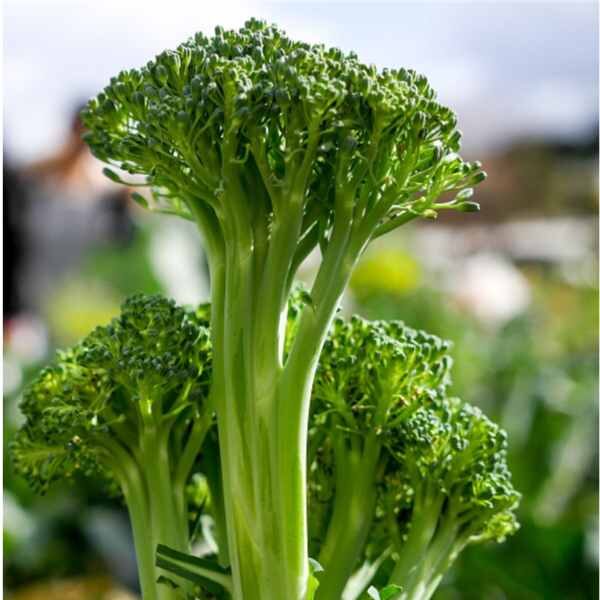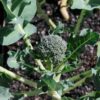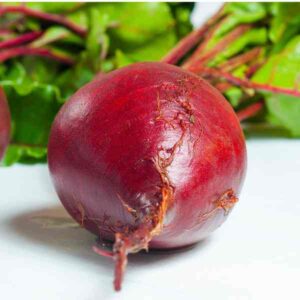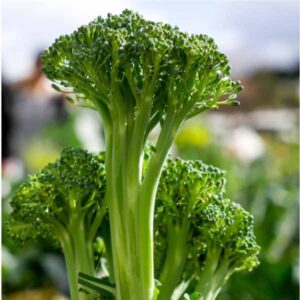Broccoli Sprouting Calabrese
$4.49
Brassica Oleracea var. Italica
- Seed Count 150
- Versatile Variety
- Annual
In stock
Description
Broccoli Sprouting Calabrese is a lovely, old fashioned Broccoli variety that is very disease resistant, very hardy and a very prolific producer of large dark green heads. The 7 to 15cm heads have a bluish green center and are typically uniform in size and shape. It will produce a number of good-size side shoots once the initial head is harvested.
Although the heads of this Broccoli variety are typically the only thing utilised, the stalks, buds and leaves are also edible. Try growing a few seed to just Micro-leaf stage and harvest with scissors when they have formed their first leaves. They are very tender with an astonishing clarity of flavour…. a true ‘superfood’.
| Method: Sow direct | Soil Temp: 7°C - 30°C |
| Cool Mountain: Oct - Mar | Position: Full sun |
| Arid: Feb - Jul | Row Spacing: 30cm apart |
| Temperate: Feb - May | Planting Depth: 3mm |
| Sub Tropical: Feb - May | Harvest: 80 Days |
| Tropical: Apr - Jul | Plant Height: 40cm |
Climate and Season
Broccoli prefers cool to mild temperatures, making it ideal for growing in most parts of Australia during autumn, winter, and early spring.
Frost Tolerance:
- Broccoli can tolerate light frost, which can even improve its flavour.
Heat Sensitivity:
- High temperatures can cause bolting (premature flowering), so avoid planting in summer in hot regions.
Soil Preparation
Broccoli requires well-draining, fertile soil with a slightly acidic to neutral pH.
Soil pH:
- 6.0–7.0.
Soil Type:
- Loamy soil rich in organic matter.
Preparation:
- Dig the soil to a depth of 30 cm.
- Incorporate well-rotted compost or aged manure to improve fertility and drainage.
- Add a balanced organic fertilizer (e.g., blood and bone or chicken manure pellets) before planting.
Seed Starting
In trays:
- Start seeds indoors 4–6 weeks before the last expected frost date.
- Sow seeds 3 mm deep in seed trays or pots.
- Transplant seedlings when they are 10–15 cm tall and have 4–6 true leaves.
Direct Sowing:
- Sow seeds directly into the garden bed, spacing them 30 cm apart.
Depth:
- Plant seedlings at the same depth as they were in their pots.
Watering
Broccoli requires consistent moisture to grow well.
Watering Frequency:
- Water deeply 2–3 times per week, depending on rainfall and soil type.
Avoid Overwatering:
- Ensure the soil is moist but not waterlogged, as this can lead to root rot.
Mulching:
- Apply a layer of organic mulch to retain soil moisture and regulate temperature.
Fertilising
At Planting:
- Broccoli is a heavy feeder, so it is important that the soil is enriched with compost, manures or balanced fertiliser before planting
- Benefits from fortnightly applications of liquid seaweed and fish solutions.
Pest and Disease Management
Broccoli is susceptible to several pests and diseases.
Common Pests:
- Cabbage white butterfly caterpillars: Use row covers or spray with *Bacillus thuringiensis* (Bt). You will find it under the brand name Dipel at most garden centres.
- Aphids: Spray with soapy water or introduce beneficial insects like ladybugs.
- Snails and slugs: Use beer traps or organic pellets.
Common Diseases:
- Clubroot: Ensure proper soil drainage and rotate crops.
- Downy mildew: Avoid overhead watering and ensure good air circulation.
- Black rot: Remove infected plants and practice crop rotation.
Harvesting
Timing:
- Harvest broccoli when the central head is firm, tight, and dark green, typically 10–16 weeks after planting.
Method:
- Cut the main head at an angle with a sharp knife, leaving 10–15 cm of stem.
- Side Shoots: After harvesting the main head, smaller side shoots will develop and can be harvested for several weeks.
Companion Planting
Good Companions
Herbs:
- Dill, rosemary, sage, and mint repel pests like cabbage moths and aphids.
Alliums:
- Garlic, onions, and leeks deter aphids and other pests.
Leafy Greens:
- Lettuce and spinach provide ground cover, reducing weeds and retaining soil moisture.
Root Vegetables:
- Beetroot and celery grow well alongside broccoli without competing for nutrients.
Flowers:
- Marigolds and nasturtiums repel pests and attract beneficial insects.
Plants to Avoid
Other Brassicas:
- Avoid planting broccoli near cabbage, cauliflower, or kale, as they attract the same pests and compete for nutrients.
Strawberries:
- They can inhibit broccoli growth.
Tomatoes:
- They may compete for nutrients and space.
Crop Rotation
- To prevent soilborne diseases and nutrient depletion, practice crop rotation.
- Avoid planting broccoli or other brassicas in the same spot more than once every 3–4 years.
- Follow broccoli with legumes (e.g., beans or peas) to replenish soil nitrogen.
Tips for Success
Succession Planting:
- Sow seeds every 2–3 weeks for a continuous harvest.
Shade Cloth:
- Use shade cloth in warmer regions to protect plants from excessive heat.
Regular Monitoring:
- Check plants weekly for pests and diseases.
Order Times
Seed orders are normally dispatched within three business days. You will receive an email when seeds are mailed out.
Postage Days
Seeds are mailed out Monday to Friday at 1pm. Except for the Friday of long weekends.
Postage Times
WA 2-3 Days: SA,NT 3-5 Days: NSW, ACT, QLD, VIC: 5-7 Days
Carrier
We use Australia Post Letter Postage for the majority of orders
Not only are our seeds packed in recycled paper envelopes, we keep the theme going when we post out website orders. To protect your seeds from moisture and the letter box munchers (snails), we use a very special plastic free material made from plants. They are then put into recycled mailing envelopes. Green all the way 💚🌿
















1 review for Broccoli Sprouting Calabrese